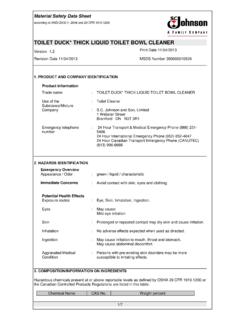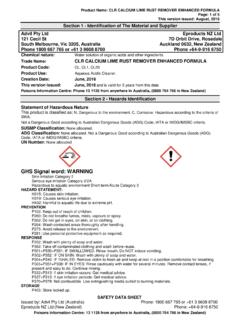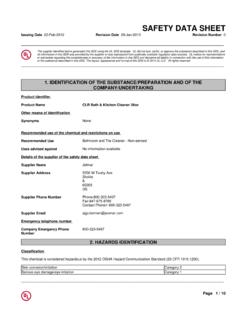Transcription of Safety Data Sheet Cabinet Rescue
1 Safety data Sheet Cabinet Rescue SDS Revision Date: 05/14/2015. 1. Identification Product identifier Product Identity Cabinet Rescue Alternate Names Product code: DT43. Product class: Waterborne Acrylic Enamel Relevant identified uses of the substance or mixture and uses advised against Intended use Protective coating Application Method See Technical data Sheet . Details of the supplier of the Safety data Sheet Company Name Decotime, Inc 2709 Swamp Cabbage Court Ste 100. Ft. Myers, FL 33901. Emergency 24 hour Emergency Telephone No.
2 (800) 373-7542. Customer Service: Decotime, Inc (800) 453-1558. 2. Hazard(s) identification Classification of the substance or mixture No applicable GHS categories. Label elements Using the Toxicity data listed in section 11 and 12 the product is labeled as follows. No applicable GHS categories. [Prevention]: No GHS prevention statements [Response]: No GHS response statements [Storage]: No GHS storage statements [Disposal]: No GHS disposal statements 3. Composition/information on ingredients This product contains the following substances that present a hazard within the meaning of the relevant State and Federal Hazardous Substances regulations.
3 Page 1 of 10. Safety data Sheet Cabinet Rescue SDS Revision Date: 05/14/2015. Ingredient/Chemical Designations Weight % GHS Classification Notes Titanium dioxide 10 - 25 Not Classified [1][2]. CAS Number: 0013463-67-7. 2-Propenoic acid, 2-methyl-, methyl ester, polymer with 10 - 25 Not Classified [1]. ethenylbenzene and 2-ethylhexyl 2-propenoate CAS Number: 0025750-06-5. Nepheline Syenite 10 - 25 Not Classified [1]. CAS Number: 0037244-96-5. Propylene Glycol - 10 Not Classified [1]. CAS Number: 0000057-55-6. 2-(2-butoxyethoxy)ethanol - 10 Eye Irrit.
4 2;H319 [1]. CAS Number: 0000112-34-5. 2,2,4-trimethyl-1,3-pentanediol monoisobutyrate - 10 Not Classified [1]. CAS Number: 0025265-77-4. Butyl Acrylate/Styrene Copolymer - 10 Eye Irrit. 2;H319 [1]. CAS Number: 0025767-47-9. In accordance with paragraph (i) of , the specific chemical identity and/or exact percentage (concentration) of composition has been withheld as a trade secret. [1] Substance classified with a health or environmental hazard. [2] Substance with a workplace exposure limit. [3] PBT-substance or vPvB-substance.
5 *The full texts of the phrases are shown in Section 16. 4. First aid measures Description of first aid measures General In all cases of doubt, or when symptoms persist, seek medical attention. Never give anything by mouth to an unconscious person. Inhalation Remove to fresh air, keep patient warm and at rest. If breathing is irregular or stopped, give artificial respiration. If unconscious place in the recovery position and obtain immediate medical attention. Give nothing by mouth. Eyes Flush eyes with large amounts of lukewarm water for 20 minutes, while holding eyelids open or until irritation subsides.
6 If irritation persist, get medical attention. Skin Remove contaminated clothing. Wash skin thoroughly with soap and water or use a recognized skin cleanser. Ingestion If patient is fully conscious, give two glasses of water. DO NOT INDUCE VOMITING. Obtain medical attention. Most important symptoms and effects, both acute and delayed Overview Effects to Acute exposure to Product: DIETHYLENE GLYCOL MONOBUTYL ETHER. has been known to cause RESPIRATORY TRACT IRRITATION, EYE IRRITATION and SKIN IRRITATION. Effects of Chronic exposure to Product: DIETHYLENE GLYCOL MONOBUTYL ETHER.
7 Has been known to cause CENTRAL NERVOUS SYSTEM DAMAGE, CYANOSIS, ACIDOSIS, KIDNEY INJURY. PROPYLENE GLYCOL has been known to cause LACTIC. ACIDOSIS. See section 2 for further details. Page 2 of 10. Safety data Sheet Cabinet Rescue SDS Revision Date: 05/14/2015. 5. Fire-fighting measures Extinguishing media Alcohol foam, carbon dioxide, dry chemical powder, polymer foam Special hazards arising from the substance or mixture Hazardous decomposition: Oxides of nitrogen, ammonia, aldehydes, hydrogen Advice for fire-fighters Hazardous Combustion Pdts: Carbon monoxide, carbon dioxide, aldehydes, nitrogen oxides, sulfur oxides, ammonium nitrate, nitrogen, nitrogen dioxide None ERG Guide No.
8 ---- 6. Accidental release measures Personal precautions, protective equipment and emergency procedures Put on appropriate personal protective equipment (see section 8). Environmental precautions Do not allow spills to enter drains or waterways. Use good personal hygiene practices. Wash hands before eating, drinking, smoking or using toilet. Promptly remove soiled clothing and wash thoroughly before reuse. Methods and material for containment and cleaning up Wear adequate protective equipment and eliminate all ignition sources.
9 Contain spill with absorbant material and place in a suitable covered and labeled container for disposal. Check with Federal, Provincial and local government regulations and requirements for disposal. 7. Handling and storage Precautions for safe handling Use in a well ventilated area. Do not use with incompatible substances and keep away from heat and all ignition sources. Use grounded and non-sparking equipment only. See section 2 for further details. - [Prevention]: Conditions for safe storage, including any incompatibilities Handle containers carefully to prevent damage and spillage.
10 Incompatible materials: Strong bases, strong acids and strong oxidizing agents Store in a cool, well ventilated area out of direct sunlight. Store away from heat and all ignition sources. Storage facility should be manufactured out of fire resistant materials. See section 2 for further details. - [Storage]: Specific end use(s). No data available. Page 3 of 10. Safety data Sheet Cabinet Rescue SDS Revision Date: 05/14/2015. 8. Exposure controls and personal protection Control parameters Exposure CAS No. Ingredient Source Value 0000057-55-6 Propylene Glycol OSHA No Established Limit ACGIH TWA(Aerosol): 10 mg/m3.



